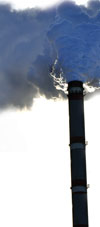

The benefits of simultaneously measuring combustibles accurately to determine breakthrough when controlling power plants on oxygen levels.
Although the science of generating power by burning fossil fuels is well understood, the reality remains that it is difficult to control the air-fuel ratio at the optimum level for maximum fuel efficiency. Too little oxygen results in unburnt fuel in the flue gases and excessive particulates (smoke, measured as opacity), while too much oxygen leads to cooler burning, a loss of fuel efficiency and an increase in emissions of oxides of nitrogen and sulphur. As opacity is often closely regulated, it is undesirable to emit excessive smoke so plants typically err on the side of excess oxygen. Those operators that successfully optimise the process often see an improvement of fuel efficiency in the order of 0,5%, which can make a substantial difference to the plant’s profitability.
Traditional control systems rely on a measurement of the oxygen level in the flue gases, plus a separate measurement of combustibles and/or carbon monoxide. In most cases the oxygen and combustibles are measured at different points on the plant and, therefore, with separate instruments that inevitably have different response times. In practice, this means that the oxygen level may creep up until the air flow has to be reduced, but the effect of this is not seen until two or three minutes later when the combustibles analyser responds. As the oxygen level will have been reduced too far breakthrough occurs, therefore the air flow has to be increased again.
Breakthrough is the point at which unburnt fuel in the gas stream rises from insignificant levels to hundreds or thousands of parts per million for a very small change in oxygen. And so the cycle continues, with continuous hunting either side of the ideal control point.
However, there is an alternative in the form of rapid response combustion analysers that measure both oxygen and combustibles at the same point. One example is the Servomex 2700 combustion gas analyser that uses a patented Zirconia cell for measuring oxygen and a thick film catalytic sensor for combustibles. A single low-flow extractive type probe is used and both sensors are installed in the same heated, insulated sensor head outside the process wall. These analysers also have flame traps fitted as standard and there is no need for a sampling system to condition the gases. Response times are better than 20 seconds for oxygen and 30 seconds for combustibles, which means that the process can be closely controlled. Breakthrough can therefore be detected extremely rapidly. As a result, the plant can be operated much closer to the optimum air-fuel ratio.
Such is the improvement in fuel efficiency that a standard fossil-fuelled power plant can expect the savings in fuel costs to pay for the gas analyser in a matter of months (running a plant with 1,5% excess of oxygen above the ideal level, typically results in a 1% increase in fuel costs). The benefits do not end there, especially for operators in countries such as the USA where mechanisms exist for trading of NOx credits. If significant reductions in NOx emissions can be achieved, it is possible for the resulting NOx credits to be more valuable than the fuel savings.
Even if trading NOx credits is not available to an operator, the reduced loading on any NOx cleanup equipment installed on the plant can also reduce the running costs. And for those whose plants occasionally run fuel-rich and therefore suffer from increased particulate levels, the improved combustion control will reduce maintenance costs.
Perhaps the most important point to note is that simultaneous measurement of oxygen and combustibles is truly economical. Field trials in the USA, Australia, UK and Portugal have shown the Servomex 2700 analyser to be capable of delivering payback within eight months. According to Servomex, back-to-back comparisons show this instrument to be more stable and reliable than alternatives and with a projected cost of ownership almost 50% lower over a 10-year period.
For more information contact Elemental Analytics, +27 (0)11 918 6994, [email protected], www.e-analytics.co.za
| Tel: | +27 11 918 6994 |
| Email: | [email protected] |
| www: | www.e-analytics.co.za |
| Articles: | More information and articles about Elemental Analytics |

© Technews Publishing (Pty) Ltd | All Rights Reserved